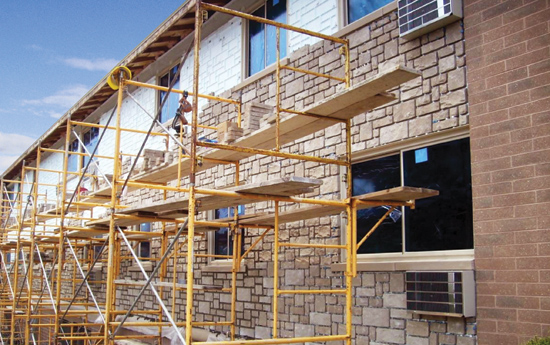Masonry Meets New Energy Codes
Getting Started in Compliance
R-value requirements for building envelope components are determined by climate zone and are also impacted by building occupancy types, wall types, and the compliance path chosen.
Climate zone. It is first necessary to determine in what climate zone the project is located. Today there are eight climate zones for the entire U.S., a vast improvement over 1989 when there were 38. Tables in the code identify the correct climate zone for every U.S. county and territory.
Building type. Section 502 of the code defines residential and commercial building types. Residential buildings include detached one- and two-family dwellings and multiple single-family dwellings (townhouses) as well as Group R-2, R-3, and R-4 buildings three stories or less in height above grade plane. The last phrase is sometimes called “light commercial.” In the energy code world, it is considered residential, primarily because the equipment and appliances used and exterior walls more closely match those used or found in a single-family house than in an office building. Commercial buildings refer to all buildings not included in the definition of “residential buildings.”
Wall type. While the IECC has reduced the number of climate zones, R-value tables have become more complex. The commercial table lists multiple variations within each envelope component, except for walls below grade, where only one type is listed. Three types of roofs, for example, four types of above-grade walls, and two types of floors make for many permutations.
 |
Continuous insulation helped a Wisconsin apartment rehab project win a government grant. Photo courtesy of Oldcastle® Architectural |
Compliance path. There are three paths to compliance: prescriptive, performance, and whole building analysis. In the prescriptive path, building design and components need to meet R-values listed in the tables. The prescriptive path is stringent and offers little flexibility, and does not take into account much individualized proposed building information, other than categories given in the tables. The performance path uses established software to measure compliance, providing less stringent requirements and more flexibility to trade off requirements. In the performance path, the designer is allowed to “build” a description of the structure, including specific information on project location, wall and window areas, orientation, the location of thermal mass relative to the exterior insulation layer, etc. If the envisioned envelope fails to meet the code requirements, it becomes a matter of adjusting the various components. To be sure, the performance path is more complex than the prescriptive path, which architects have traditionally followed. But with software becoming easier to use and the design flexibility it offers in meeting more stringent code requirements, the performance path may be more readily embraced in coming years. While not explicitly referenced in the IECC, the ASHRAE standard on which the IECC is based, specifically names two computer programs that are designed for use by the average architect.
Another path to compliance uses the whole building analysis. While this method requires even more complex software, tradeoffs are allowed among envelope components, HVAC systems, and lighting. For example, the whole building path may allow lower R-value wall material in exchange for pre-heating incoming “fresh” air. While not widely used today, the whole building path may be the main method in future years as it analyzes a building's total energy use, rather than compliance of individual components.









